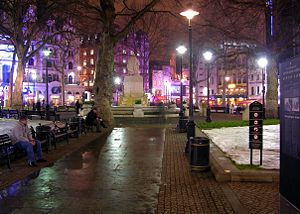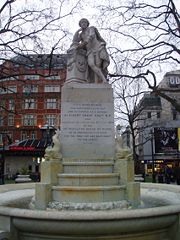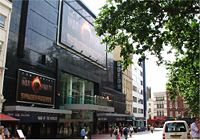Leicester Square

- For the British guitarist, see Lester Square.
Leicester Square (pronounced /ˈlɛstɚ/) is a pedestrianised square in the West End of London, England. The Square lies within an area bound by Lisle Street, to the north; Charing Cross Road, to the east; Orange Street, to the south; and Whitcomb Street, to the west. The park at the centre of the Square is bound by Cranbourn Street, to the north; Leicester Street, to the east; Irving Street, to the south; and a section of road designated simply as Leicester Square, to the west. It is within the City of Westminster, and about equal distances (about 400 yards (370 m)) north of Trafalgar Square, east of Piccadilly Circus, west of Covent Garden, and south of Cambridge Circus.
Contents |
History

The Square is named after Robert Sidney, 2nd Earl of Leicester, who purchased four acres (1.6 hectares) in St. Martin's Field in 1630; by 1635, he had built himself a large house, Leicester House, at the northern end. The area in front of the house was then enclosed, depriving inhabitants of St. Martin's Parish of their right to use the previously common land. The parishioners appealed to King Charles I, and he appointed three members of the Privy Council to arbitrate. Lord Leicester was ordered to keep part of his land (thereafter known as Leicester Field and later as Leicester Square) open for the parishioners[1].
The area was developed in the 1670s. It was initially fashionable and Leicester House was once residence of Frederick, Prince of Wales but by the late 18th century, the Square was no longer a smart address and began to serve as a venue for popular entertainments. Leicester House became home of a museum of natural curiosities called the Holophusikon in the 1780s and was demolished about 1791–1792[1].
In 1848, Leicester Square was the subject of the land-law case of Tulk vs. Moxhay. The plot's previous owner had agreed upon a covenant not to erect buildings. However, the law would not allow purchasers who were not 'privy' to the initial contract to be bound by subsequent promises. The judge, Lord Cottenham, decided that future owners could be bound by promises to abstain from activity. Otherwise, a buyer could sell land to himself to undermine an initial promise[2]. Arguments continued about the fate of the garden, with Tulk's heirs erecting a wooden hoarding around the property in 1873. Finally, in 1874 the flamboyant Albert Grant (1830–1899) purchased the outstanding freeholds and donated the garden to the Metropolitan Board of Works, laying out a garden at his own expense. The title passed to the succeeding public bodies and is now in the ownership of the City of Westminster[3].
By the 19th century, Leicester Square was known as an entertainment venue, with many amusements peculiar to the era including Wyld's Globe which was built for the great exhibition and housed a giant scale map of the Earth[4]. Several hotels grew up around the square making it popular with visitors to London. A large theatre, the Alhambra, built in 1854, dominated the site[5], to be joined in 1884 by the Empire Theatre of Varieties. The square remains the heart of the West End entertainment district today.
Features
Gardens


In the middle of the Square is a small park, in the centre of which is a 19th century statue of William Shakespeare surrounded by dolphins. The four corner gates of the park have one bust each, depicting Sir Isaac Newton, the scientist; Sir Joshua Reynolds, the first President of the Royal Academy; John Hunter, a pioneer of surgery; and William Hogarth, the painter. The most recent addition is a statue of film star and director Charlie Chaplin. On the pavement are inscribed the distances in miles to countries of the former British Empire.
Entertainment

Leicester Square is the centre of London's cinema land, and one of the signs marking the Square bears the legend "Theatreland." It is claimed that the Square contains the cinema with the largest screen and the cinema with the most seats (over 1600). The square is the prime location in London for major film premieres and has seen the likes of James Bond films, animation films such as Shrek and even co-hosts the London Film Festival each year. Similar to Grauman's Chinese Theatre in Hollywood, the square is surrounded by floor mounted plaques with film stars names and cast handprints.
The Square is also the home for 'tkts', formerly known as the Official London Half-Price Theatre Ticket Booth. This booth is jointly operated by TKTS and LondonTown.com. Tickets for theatre performances taking place around the West End that day are sold from the booth for about half the usual price. The popularity of the booth has given rise to many other booths and stores around the Square that advertise half-price tickets for West End shows. It is claimed that at least some of these booths operate fraudulently. Despite having names like 'Official Half-Price Ticket Booth', they are not official and they do not always advertise the booking fees which commonly come with purchasing tickets.
The Square is home to several nightclubs, making it often very busy, particularly on Friday and Saturday evenings.
Major cinemas


- Odeon Leicester Square, which dominates the east side of the square, had the first digital projector in Europe (1999), hosting most premieres with capacity for 1942 people, arranged in circle and stalls.
- The adjacent Odeon Mezzanine has five smaller auditoria (capacities of 50–60 each).
- Empire, on the north of the Square, is the next-largest cinema, with 1,330 seats before the main screen (the only THX certified screen in the square), as well as four smaller screens, with 350, 96, 77 and 50 seats. 3 of the screens are digital. Many premieres are hosted here.
- Odeon West End, on the south side, contains two screens, which can seat 1,000 each, and is used for smaller premières.
- Vue, on the north side, near the north east corner, was previously the Warner Brothers Village, a multiplex that hosted only Warner Bros. film premieres. Together with the rest of the Warner Village chain, it was bought out by Vue in 2004.
Other cinemas
- A short distance from the west of the Square, on the south side of Panton Street, is the Odeon Panton Street, another four-screen Odeon cinema.
- Just to the North of the square, Prince Charles Cinema is a cheap-ticket second-run and cult cinema famed for its regular showing of The Rocky Horror Picture Show and a sing-along version of The Sound of Music.
- Cineworld is a short distance down Coventry Street in the Trocadero Centre.
Clubs, bars, restaurants
Just off Leicester Square
- Hippodrome, London
- The Comedy Store
- The Venue Leicester Square (West End theatre)
Media
Global Radio has its headquarters on the east side of Leicester Square, close to the Odeon Leicester Square. The building houses the radio stations Capital 95.8, Classic FM, Xfm London, Choice FM, Gold and soon Heart will be moving in ready for first transmission on November 26th 2008, and LBC will follow on December 9th 2008.
In what was formerly Home (a seven-floor superclub launched in 1999, which went into receivership[6] after having its licence revoked by police for one month[7] in March 2001 because of drugs issues, and at which Paul Oakenfold was a resident D.J.), is now an MTV UK television studio, used for the UK version of Total Request Live and the Russell Brand–fronted show 1 Leicester Square. It was also used for the first series of BBC Saturday morning show TMi.
Other attractions
The square regularly hosts a fair each winter and a stage is erected for performances connected to other events such as Chinese New Year.
Infrastructure
The main electric substation for the West End is beneath the Square. The electrical cables to the substation are in a large tunnel ending at Leicester Square, and originating in Wimbledon, at Plough Lane, behind the former Wimbledon FC football ground, before which the cables are above ground. [8].
The square is set to change in its appearance over the next few years as Westminster Council are planning a new design. The change would still retain its character but make it more of a major square for film premieres.
References
- ↑ 1.0 1.1 Leicester Square, North Side, and Lisle Street Area: Leicester Estate: Leicester House and Leicester Square North Side (Nos 1-16), Survey of London: volumes 33 and 34: St Anne Soho (1966), pp. 441-472 accessed: 06 November 2007
- ↑ Tulk v. Moxhay (1848) 41 ER 1143 (Court Rolls)
- ↑ Leicester Square Area: Leicester Estate, Survey of London: volumes 33 and 34: St Anne Soho (1966), pp. 416-440 accessed: 06 November 2007
- ↑ A Journey Round the Globe Punch (Jul.-Dec. 1851) (Victorian London) accessed 6 Nov 2007
- ↑ Alhambra Theatre (Arthur Lloyd) accessed 23 Oct 2007
- ↑ BBC News | MUSIC | Home club owners in receivership
- ↑ BBC News | MUSIC | Home nightclub shut by police
- ↑ Tunnelling Under London: Developments in cable tunnel design provide an economic and environmental solution to system reinforcement John Mathews (London Electricity, 1996) accessed 6 Nov 2007
See also
- Leicester Square tube station
- List of eponymous roads in London
External links
- Leicester Square Webcam - 8 preset views from the Radisson Edwardian Hampshire Hotel
- Detailed information about the history and buildings of Leicester Square from the Survey of London
- Leicester Square webcam
- More on the history of Leicester Square at www.VictorianLondon.org
- Leicester Square Television